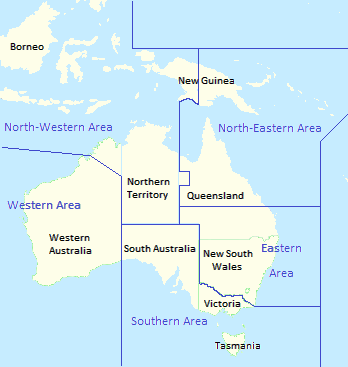North-Western Area Command (RAAF)
| North-Western Area Command | |
|---|---|

RAAF area commands in November 1942
|
|
| Active | 1942–55 |
| Allegiance | Australia |
| Branch | Royal Australian Air Force |
| Role | Air defence Aerial reconnaissance Protection of adjacent sea lanes |
| Garrison/HQ | Darwin, Northern Territory |
| Engagements | World War II |
| Commanders | |
| Notable commanders |
Douglas Wilson (1942) Frank Bladin (1942–43) Adrian Cole (1943–44) Alan Charlesworth (1944–46) Frank Headlam (1946) Glen Cooper (1952–53) |
North-Western Area Command was one of several geographically based commands raised by the Royal Australian Air Force (RAAF) during World War II. Its wartime sphere of operations included the Northern Territory, adjacent portions of Queensland and Western Australia, and the Dutch East Indies. The command was formed in January 1942, following the outbreak of the Pacific War, from the western part of Northern Area Command, which had covered all of northern Australia and Papua. Headquartered at Darwin, North-Western Area Command was initially responsible for air defence, aerial reconnaissance and protection of the sea lanes within its boundaries.
In the official history of the RAAF in the Pacific theatre, George Odgers described the North-Western Area Campaign as "almost entirely an air war, with raid and counter-raid". From 1943, North-Western Area Command's role became increasingly offensive in nature, as the Allies began to advance in New Guinea and the Dutch East Indies. The command continued to operate following the end of the war, its boundaries being reduced to Australian territory. In February 1954, its responsibilities were subsumed by the RAAF's newly established functional command-and-control system; the headquarters was disbanded the following year.
North-Western Area Command was formed at RAAF Station Darwin, Northern Territory, on 15 January 1942, taking over the western portion of what was Northern Area Command. Northern Area had been established on 8 May 1941 as one of the RAAF's four geographically based command-and-control zones, and covered northern New South Wales, Queensland, the Northern Territory, and Papua. The roles of the area commands were air defence, protection of adjacent sea lanes, and aerial reconnaissance. Each was led by an Air Officer Commanding (AOC) responsible for the administration and operations of air bases and units within his boundary.
...
Wikipedia
